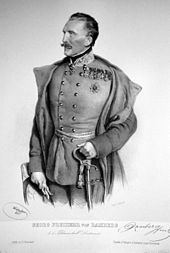Georg Heinrich von Ramberg

Georg Heinrich Freiherr von Ramberg (born February 25, 1786 in Hanover , † September 2, 1855 in Teplitz ) was an Austrian Lieutenant Field Marshal .
Life
Georg von Ramberg distinguished himself as a staff officer in many campaigns, but also worked as a diplomat and cartographer . In 1805, at the age of 19, he joined the Prussian army and took part in the campaigns against Napoleon on the staff of Scharnhorst .
After the Peace of Tilsit he left the Prussian Army and entered Austrian service in 1808. In 1809 he was assigned to the general quartermaster staff and took part in the campaign in Bavaria at the headquarters of Archduke Karl . In the battles of Aspern and Wagram , he distinguished himself.
From 1810 to 1812 he was entrusted with mapping Hungary when describing the country . He took part in the campaigns of 1813 and 1814 in staff positions. In 1815 he was assigned to the Wellington Headquarters as a liaison officer. In 1835 he was made a colonel , in 1843 a major general , and in 1848 a field marshal lieutenant.
He played a key role in the siege of Vienna against the October uprising in Vienna in 1848 . His troops advanced through Brigittenau and in Augarten, on October 28th his division took part in the assault on Leopoldstadt and sent two brigades to take part in the battle of Schwechat . In the campaigns that followed against the rebellious Hungarians, he distinguished himself several times and was awarded the Knight's Cross of the Maria Theresa Order on March 26, 1849 .
As part of the II Army Corps, his troops fought on the small Schütt at the end of 1848 . With an independent corps he initially blocked the Komorn fortress and in February 1849 pursued the Hungarian corps Görgey via Kosice to the Tisza . After a long illness, he took over the leadership of III under the new Commander-in-Chief in Hungary, Feldzeugmeister Haynau . Corps with which he entered Pesth on July 12th . With the resumption of the advance of the imperial army, he led his troops via Maria Theresianopel to Kis-Kanizsa and forced the Tisza crossing on August 5th. After battles at Besenyö, Czatad and Jeczö, his III. Corps took part in the decisive battle at Temesvár . The Hungarians pursued his troops to Transylvania , where his avant-garde met the enemy at Lugos , who gave up his arms at Déva on August 19th .
In the fall of 1849 he became the commander of the XII. Corps in Transylvania and in the Banat. From 1850 until his retirement in 1854 he was in command of the Theresienstadt fortress .
family
Ramberg's uncle was the Hanoverian painter Johann Heinrich Ramberg (1763-1840). His son Arthur von Ramberg (1819–1875) was an Austrian painter and draftsman. Another son Hermann von Ramberg (1820–1899) was an Austrian general of the cavalry . His great-nephew August von Ramberg (1866–1947) became an Austrian marine painter .
honors and awards
In the course of his career he received the English Bath and Russian Order of Vladimir . He was a knight of the French Legion of Honor , as well as a knight of the Maria Theresa Order . He was also commander of the Leopold Order and was elevated to the status of Austrian baron in 1850 .
literature
- Military Schematism of the Austrian Empire. Vienna 1834, p. 373.
- Military Schematism of the Austrian Empire. Vienna 1846, p. 49.
- Constantin von Wurzbach : Ramberg, Georg Heinrich Freiherr von . In: Biographisches Lexikon des Kaiserthums Oesterreich . 24th part. Kaiserlich-Königliche Hof- und Staatsdruckerei, Vienna 1872, pp. 307–310 ( digitized version ).
- R. v. R .: Ramberg, Georg Heinrich Freiherr von . In: Allgemeine Deutsche Biographie (ADB). Volume 27, Duncker & Humblot, Leipzig 1888, pp. 205-207.
| personal data | |
|---|---|
| SURNAME | Ramberg, Georg Heinrich von |
| ALTERNATIVE NAMES | Ramberg, Georg Heinrich Freiherr von |
| BRIEF DESCRIPTION | Prussian-Austrian officer |
| DATE OF BIRTH | February 25, 1786 |
| PLACE OF BIRTH | Hanover |
| DATE OF DEATH | September 2, 1855 |
| Place of death | Teplitz |